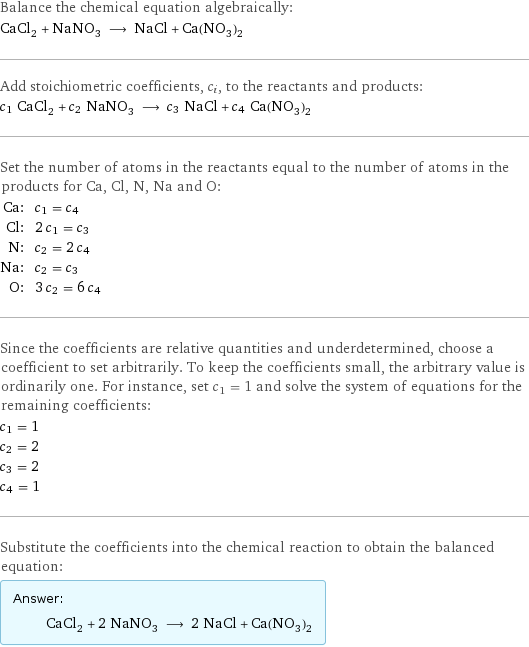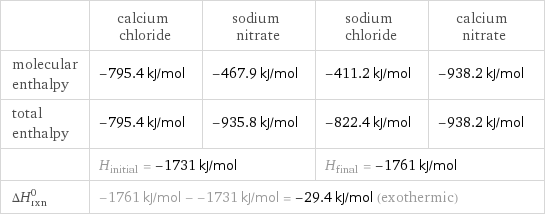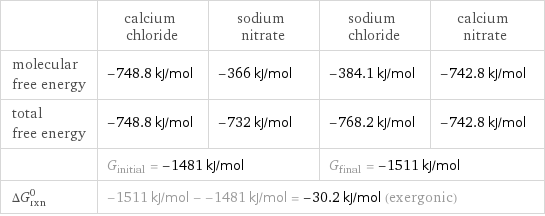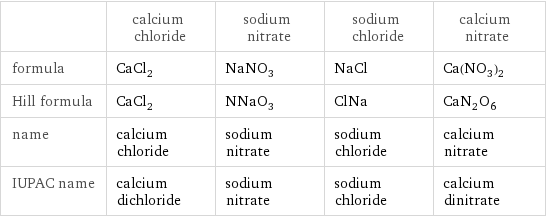Input interpretation

CaCl_2 calcium chloride + NaNO_3 sodium nitrate ⟶ NaCl sodium chloride + Ca(NO_3)_2 calcium nitrate
Balanced equation

Balance the chemical equation algebraically: CaCl_2 + NaNO_3 ⟶ NaCl + Ca(NO_3)_2 Add stoichiometric coefficients, c_i, to the reactants and products: c_1 CaCl_2 + c_2 NaNO_3 ⟶ c_3 NaCl + c_4 Ca(NO_3)_2 Set the number of atoms in the reactants equal to the number of atoms in the products for Ca, Cl, N, Na and O: Ca: | c_1 = c_4 Cl: | 2 c_1 = c_3 N: | c_2 = 2 c_4 Na: | c_2 = c_3 O: | 3 c_2 = 6 c_4 Since the coefficients are relative quantities and underdetermined, choose a coefficient to set arbitrarily. To keep the coefficients small, the arbitrary value is ordinarily one. For instance, set c_1 = 1 and solve the system of equations for the remaining coefficients: c_1 = 1 c_2 = 2 c_3 = 2 c_4 = 1 Substitute the coefficients into the chemical reaction to obtain the balanced equation: Answer: | | CaCl_2 + 2 NaNO_3 ⟶ 2 NaCl + Ca(NO_3)_2
Structures

+ ⟶ +
Names

calcium chloride + sodium nitrate ⟶ sodium chloride + calcium nitrate
Reaction thermodynamics
Enthalpy

| calcium chloride | sodium nitrate | sodium chloride | calcium nitrate molecular enthalpy | -795.4 kJ/mol | -467.9 kJ/mol | -411.2 kJ/mol | -938.2 kJ/mol total enthalpy | -795.4 kJ/mol | -935.8 kJ/mol | -822.4 kJ/mol | -938.2 kJ/mol | H_initial = -1731 kJ/mol | | H_final = -1761 kJ/mol | ΔH_rxn^0 | -1761 kJ/mol - -1731 kJ/mol = -29.4 kJ/mol (exothermic) | | |
Gibbs free energy

| calcium chloride | sodium nitrate | sodium chloride | calcium nitrate molecular free energy | -748.8 kJ/mol | -366 kJ/mol | -384.1 kJ/mol | -742.8 kJ/mol total free energy | -748.8 kJ/mol | -732 kJ/mol | -768.2 kJ/mol | -742.8 kJ/mol | G_initial = -1481 kJ/mol | | G_final = -1511 kJ/mol | ΔG_rxn^0 | -1511 kJ/mol - -1481 kJ/mol = -30.2 kJ/mol (exergonic) | | |
Equilibrium constant
![Construct the equilibrium constant, K, expression for: CaCl_2 + NaNO_3 ⟶ NaCl + Ca(NO_3)_2 Plan: • Balance the chemical equation. • Determine the stoichiometric numbers. • Assemble the activity expression for each chemical species. • Use the activity expressions to build the equilibrium constant expression. Write the balanced chemical equation: CaCl_2 + 2 NaNO_3 ⟶ 2 NaCl + Ca(NO_3)_2 Assign stoichiometric numbers, ν_i, using the stoichiometric coefficients, c_i, from the balanced chemical equation in the following manner: ν_i = -c_i for reactants and ν_i = c_i for products: chemical species | c_i | ν_i CaCl_2 | 1 | -1 NaNO_3 | 2 | -2 NaCl | 2 | 2 Ca(NO_3)_2 | 1 | 1 Assemble the activity expressions accounting for the state of matter and ν_i: chemical species | c_i | ν_i | activity expression CaCl_2 | 1 | -1 | ([CaCl2])^(-1) NaNO_3 | 2 | -2 | ([NaNO3])^(-2) NaCl | 2 | 2 | ([NaCl])^2 Ca(NO_3)_2 | 1 | 1 | [Ca(NO3)2] The equilibrium constant symbol in the concentration basis is: K_c Mulitply the activity expressions to arrive at the K_c expression: Answer: | | K_c = ([CaCl2])^(-1) ([NaNO3])^(-2) ([NaCl])^2 [Ca(NO3)2] = (([NaCl])^2 [Ca(NO3)2])/([CaCl2] ([NaNO3])^2)](../image_source/46717c335271fb4924a80d75763f0f81.png)
Construct the equilibrium constant, K, expression for: CaCl_2 + NaNO_3 ⟶ NaCl + Ca(NO_3)_2 Plan: • Balance the chemical equation. • Determine the stoichiometric numbers. • Assemble the activity expression for each chemical species. • Use the activity expressions to build the equilibrium constant expression. Write the balanced chemical equation: CaCl_2 + 2 NaNO_3 ⟶ 2 NaCl + Ca(NO_3)_2 Assign stoichiometric numbers, ν_i, using the stoichiometric coefficients, c_i, from the balanced chemical equation in the following manner: ν_i = -c_i for reactants and ν_i = c_i for products: chemical species | c_i | ν_i CaCl_2 | 1 | -1 NaNO_3 | 2 | -2 NaCl | 2 | 2 Ca(NO_3)_2 | 1 | 1 Assemble the activity expressions accounting for the state of matter and ν_i: chemical species | c_i | ν_i | activity expression CaCl_2 | 1 | -1 | ([CaCl2])^(-1) NaNO_3 | 2 | -2 | ([NaNO3])^(-2) NaCl | 2 | 2 | ([NaCl])^2 Ca(NO_3)_2 | 1 | 1 | [Ca(NO3)2] The equilibrium constant symbol in the concentration basis is: K_c Mulitply the activity expressions to arrive at the K_c expression: Answer: | | K_c = ([CaCl2])^(-1) ([NaNO3])^(-2) ([NaCl])^2 [Ca(NO3)2] = (([NaCl])^2 [Ca(NO3)2])/([CaCl2] ([NaNO3])^2)
Rate of reaction
![Construct the rate of reaction expression for: CaCl_2 + NaNO_3 ⟶ NaCl + Ca(NO_3)_2 Plan: • Balance the chemical equation. • Determine the stoichiometric numbers. • Assemble the rate term for each chemical species. • Write the rate of reaction expression. Write the balanced chemical equation: CaCl_2 + 2 NaNO_3 ⟶ 2 NaCl + Ca(NO_3)_2 Assign stoichiometric numbers, ν_i, using the stoichiometric coefficients, c_i, from the balanced chemical equation in the following manner: ν_i = -c_i for reactants and ν_i = c_i for products: chemical species | c_i | ν_i CaCl_2 | 1 | -1 NaNO_3 | 2 | -2 NaCl | 2 | 2 Ca(NO_3)_2 | 1 | 1 The rate term for each chemical species, B_i, is 1/ν_i(Δ[B_i])/(Δt) where [B_i] is the amount concentration and t is time: chemical species | c_i | ν_i | rate term CaCl_2 | 1 | -1 | -(Δ[CaCl2])/(Δt) NaNO_3 | 2 | -2 | -1/2 (Δ[NaNO3])/(Δt) NaCl | 2 | 2 | 1/2 (Δ[NaCl])/(Δt) Ca(NO_3)_2 | 1 | 1 | (Δ[Ca(NO3)2])/(Δt) (for infinitesimal rate of change, replace Δ with d) Set the rate terms equal to each other to arrive at the rate expression: Answer: | | rate = -(Δ[CaCl2])/(Δt) = -1/2 (Δ[NaNO3])/(Δt) = 1/2 (Δ[NaCl])/(Δt) = (Δ[Ca(NO3)2])/(Δt) (assuming constant volume and no accumulation of intermediates or side products)](../image_source/79016e94d2f219b9fe9cbb2106d02cb4.png)
Construct the rate of reaction expression for: CaCl_2 + NaNO_3 ⟶ NaCl + Ca(NO_3)_2 Plan: • Balance the chemical equation. • Determine the stoichiometric numbers. • Assemble the rate term for each chemical species. • Write the rate of reaction expression. Write the balanced chemical equation: CaCl_2 + 2 NaNO_3 ⟶ 2 NaCl + Ca(NO_3)_2 Assign stoichiometric numbers, ν_i, using the stoichiometric coefficients, c_i, from the balanced chemical equation in the following manner: ν_i = -c_i for reactants and ν_i = c_i for products: chemical species | c_i | ν_i CaCl_2 | 1 | -1 NaNO_3 | 2 | -2 NaCl | 2 | 2 Ca(NO_3)_2 | 1 | 1 The rate term for each chemical species, B_i, is 1/ν_i(Δ[B_i])/(Δt) where [B_i] is the amount concentration and t is time: chemical species | c_i | ν_i | rate term CaCl_2 | 1 | -1 | -(Δ[CaCl2])/(Δt) NaNO_3 | 2 | -2 | -1/2 (Δ[NaNO3])/(Δt) NaCl | 2 | 2 | 1/2 (Δ[NaCl])/(Δt) Ca(NO_3)_2 | 1 | 1 | (Δ[Ca(NO3)2])/(Δt) (for infinitesimal rate of change, replace Δ with d) Set the rate terms equal to each other to arrive at the rate expression: Answer: | | rate = -(Δ[CaCl2])/(Δt) = -1/2 (Δ[NaNO3])/(Δt) = 1/2 (Δ[NaCl])/(Δt) = (Δ[Ca(NO3)2])/(Δt) (assuming constant volume and no accumulation of intermediates or side products)
Chemical names and formulas

| calcium chloride | sodium nitrate | sodium chloride | calcium nitrate formula | CaCl_2 | NaNO_3 | NaCl | Ca(NO_3)_2 Hill formula | CaCl_2 | NNaO_3 | ClNa | CaN_2O_6 name | calcium chloride | sodium nitrate | sodium chloride | calcium nitrate IUPAC name | calcium dichloride | sodium nitrate | sodium chloride | calcium dinitrate
Substance properties

| calcium chloride | sodium nitrate | sodium chloride | calcium nitrate molar mass | 111 g/mol | 84.994 g/mol | 58.44 g/mol | 164.09 g/mol phase | solid (at STP) | solid (at STP) | solid (at STP) | solid (at STP) melting point | 772 °C | 306 °C | 801 °C | 562 °C boiling point | | | 1413 °C | density | 2.15 g/cm^3 | 2.26 g/cm^3 | 2.16 g/cm^3 | 2.5 g/cm^3 solubility in water | soluble | soluble | soluble | soluble dynamic viscosity | | 0.003 Pa s (at 250 °C) | | odor | | | odorless |
Units
